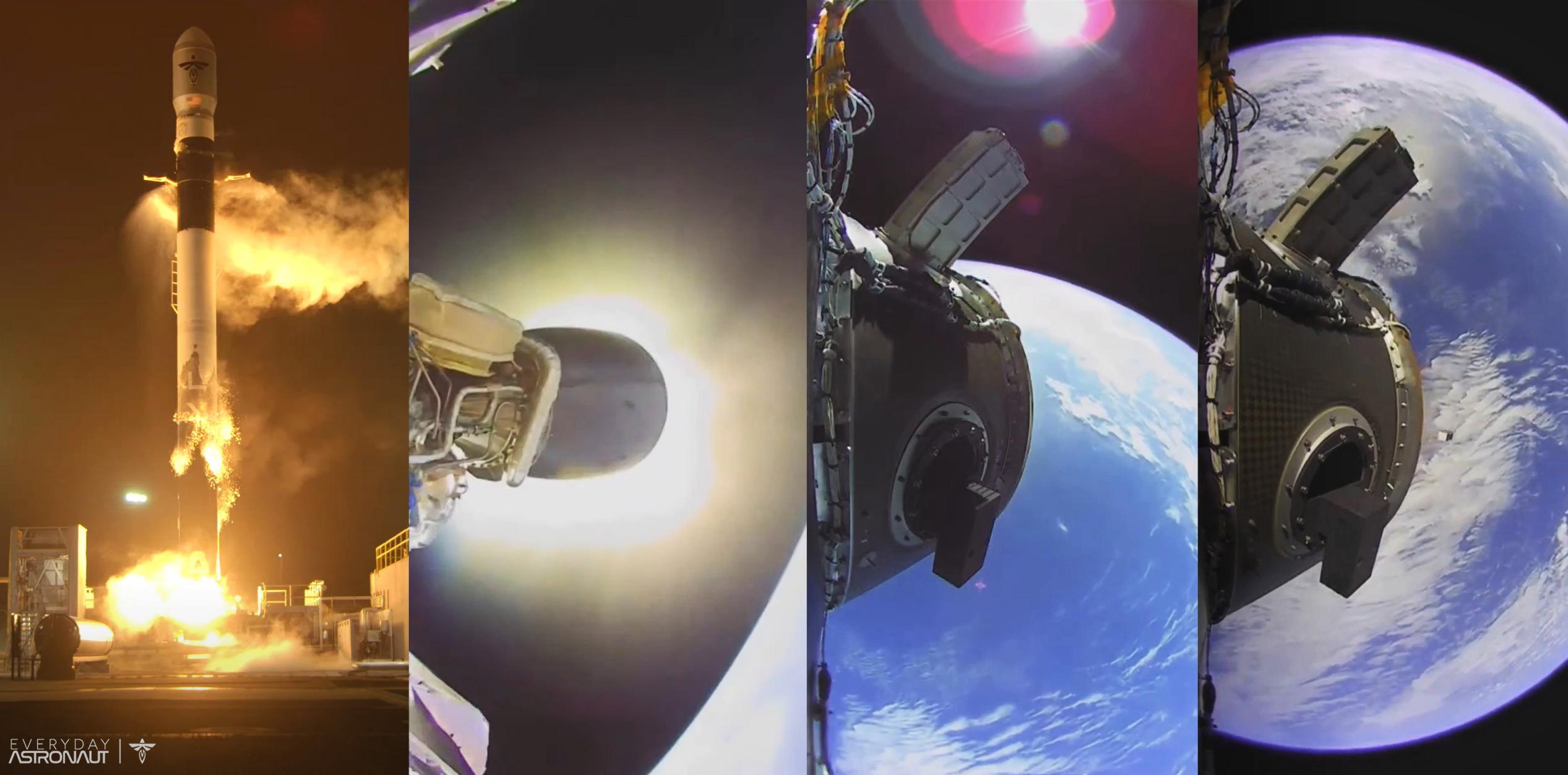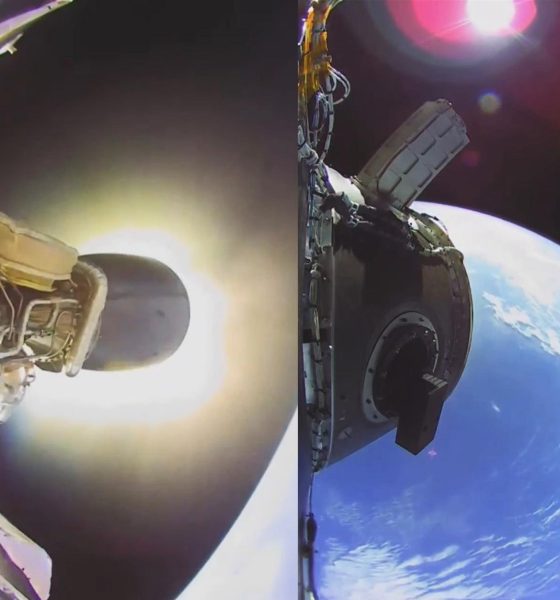

News
Firefly launches world’s largest carbon fiber rocket into orbit on second try
Firefly Aerospace’s Alpha rocket has successfully reached orbit on its second try, cementing the company as the victor of a mostly unintentional race between three American NewSpace startups.
After weeks of delays and three aborted launch attempts on September 11th, 12th, and 30th, the second carbon-fiber Alpha rocket lifted off from its Vandenberg Space Force Base (VSFB) SLC-2W launch pad at 12:01 am PDT (07:01 UTC) on October 1st. According to Firefly, the resulting mission was a “100%…success”, indicating that it achieved all of the company’s objectives – an outcome far from guaranteed on the second flight of any orbital rocket.
In a familiar display, Alpha’s suborbital booster lifted the upper stage, fairing, and payload most of the way out of the Earth’s atmosphere within a few minutes. After a mechanical system pushed the two stages apart, the upper stage successfully ignited its lone Lightning engine, ejected the two-piece fairing (nose cone) protecting its payloads, and continued uphill for another five minutes before reaching a stable parking orbit around 250 kilometers (~160 mi) above Earth’s surface.
After successfully reaching orbit, Alpha’s upper stage even made it through a more than 90-minute coast phase and reignited for a brief second burn. Finally, Alpha managed to deploy all seven of the satellites it lifted off with. As a test flight, there was no guarantee that those payloads would end up anywhere other than the Pacific Ocean, so the successful deployment was likely a very pleasant surprise for all satellite operators involved in the mission.
Nicknamed “Into The Black” by Firefly, it was the company’s second Alpha flight and followed an unsuccessful attempt on September 3rd, 2021. During the rocket’s first launch, a loose cable caused one of its booster’s four main Reaver engines to fail almost immediately after liftoff, dooming the attempt. However, the rest of the booster fought for more than two minutes to keep the mission on track before a termination system destroyed the rocket, demonstrating otherwise excellent performance and gathering invaluable data and experience.
Firefly wasted no time putting that experience to good use. Compared to the first vehicle, the booster and upper stage for Alpha’s second flight sailed through preflight testing and completed their respective proof tests (a combined wet dress rehearsal and static fire) on their first tries. That smooth processing bodes well for the timing of Firefly’s third Alpha launch, although the company’s official accounts have strangely been almost silent after Flight 2’s success.
Soon after launch, third-party data showed that Alpha deployed its seven payloads into a 210 x 270 kilometer (130 x 170 mi) orbit. Firefly’s official launch page had stated that the target orbit was 300 kilometers (~185 mi) and called the second ignition of the upper stage a “circularization burn.” Given that the final orbit is far from circular and has an apogee a full 10% below that stated target, it wasn’t clear the rocket had performed exactly as expected. The orbit’s very low perigee means that the customer satellites Alpha deployed could reenter Earth’s atmosphere and burn up after a matter of weeks in space, rather than months or years.
But according to Bill Weber, who became CEO of Firefly less than a month before the launch, Alpha “deployed [Firefly’s] customer payloads at exactly the spot [the company] intended,” strongly implying that the strange final orbit was intentional.
Additionally, official footage Firefly released after the launch suggests that Alpha’s upper stage Lightning engine nozzle narrowly missed the booster’s interstage during stage separation. Had the drifting booster hit that nozzle, it would have likely caused the upper stage to begin tumbling and potentially ended the mission well before orbit. Thankfully, it didn’t, and it should be relatively easy to fix whatever caused the Alpha booster to begin slipping sideways so quickly after separation.
Alpha is the largest all-carbon-fiber rocket ever built. It stands 29.5 meters (~95 ft) tall, 1.8 meters (6 ft) wide, weighs 54 tons (~120,000 lb) fully fueled, and can produce up 81 tons of thrust (~180,000 lbf). Alpha can launch up to 1.17 tons ~(2600 lb) of useful cargo to low Earth orbit (LEO), making it the first successful entrant in a new and rapidly growing field of privately-developed rockets designed to launch 1-2 tons to orbit.
Coincidentally, Firefly found itself neck and neck with two other prospective US providers, Relativity Space and ABL Space. For several months, all three companies were aiming to successfully launch their one-ton-class rockets to orbit sometime in the late summer or early fall. But despite delays, Firefly – already more than a year ahead after its first launch attempt in 2021 – still beat Relativity and ABL Space to flight and did so successfully, securing itself a small but significant milestone in the history of private spaceflight.
The timeline for Relativity’s first 3D-printed Terran-1 rocket launch is no longer clear after a hurricane disrupted its preflight test campaign. ABL Space, meanwhile, has been forced to sit with its first RS1 rocket ready to launch for weeks while waiting on the FAA to complete paperwork and grant it a launch license. Had the FAA moved faster, it’s entirely possible that ABL Space could have launched before Firefly’s Alpha Flight 2, although the odds of success are much lower for RS1 during its debut. Pending that regulatory approval, ABL Space intends to launch RS1 out of Kodiak, Alaska as early as mid-October.
Firefly has yet to offer a substantial statement after the successful launch, which means that the company has provided no information about its next steps or next launch. Per prior statements, the company is working to upgrade its Texas factory to enable up to six Alpha launches in 2023.

Elon Musk
Starlink achieves major milestones in 2025 progress report
Starlink wrapped up 2025 with impressive growth, adding more than 4.6 million new active customers and expanding service to 35 additional countries, territories, and markets.

Starlink wrapped up 2025 with impressive growth, adding more than 4.6 million new active customers and expanding service to 35 additional countries, territories, and markets. The company also completed deployment of its first-generation Direct to Cell constellation, launching over 650 satellites in just 18 months to enable cellular connectivity.
SpaceX highlighted Starlink’s impressive 2025 progress in an extensive report.
Key achievements from Starlink’s 2025 Progress
Starlink connected over 4.6 million new customers with high-speed internet while bringing service to 35 more regions worldwide in 2025. Starlink is now connecting 9.2 million people worldwide. The service achieved this just weeks after hitting its 8 million customer milestone.
Starlink is now available in 155 markets, including areas that are unreachable by traditional ISPs. As per SpaceX, Starlink has also provided over 21 million airline passengers and 20 million cruise passengers with reliable high-speed internet connectivity during their travels.
Starlink Direct to Cell
Starlink’s Direct to Cell constellation, more than 650 satellites strong, has already connected over 12 million people at least once, marking a breakthrough in global mobile coverage.
Starlink Direct to Cell is currently rolled out to 22 countries and 6 continents, with over 6 million monthly customers. Starlink Direct to Cell also has 27 MNO partners to date.
“This year, SpaceX completed deployment of the first generation of the Starlink Direct to Cell constellation, with more than 650 satellites launched to low-Earth orbit in just 18 months. Starlink Direct to Cell has connected more than 12 million people, and counting, at least once, providing life-saving connectivity when people need it most,” SpaceX wrote.
News
Tesla Giga Nevada celebrates production of 6 millionth drive unit
To celebrate the milestone, the Giga Nevada team gathered for a celebratory group photo.

Tesla’s Giga Nevada has reached an impressive milestone, producing its 6 millionth drive unit as 2925 came to a close.
To celebrate the milestone, the Giga Nevada team gathered for a celebratory group photo.
6 million drive units
The achievement was shared by the official Tesla Manufacturing account on social media platform X. “Congratulations to the Giga Nevada team for producing their 6 millionth Drive Unit!” Tesla wrote.
The photo showed numerous factory workers assembled on the production floor, proudly holding golden balloons that spelled out “6000000″ in front of drive unit assembly stations. Elon Musk gave credit to the Giga Nevada team, writing, “Congrats on 6M drive units!” in a post on X.
Giga Nevada’s essential role
Giga Nevada produces drive units, battery packs, and energy products. The facility has been a cornerstone of Tesla’s scaling since opening, and it was the crucial facility that ultimately enabled Tesla to ramp the Model 3 and Model Y. Even today, it serves as Tesla’s core hub for battery and drivetrain components for vehicles that are produced in the United States.
Giga Nevada is expected to support Tesla’s ambitious 2026 targets, including the launch of vehicles like the Tesla Semi and the Cybercab. Tesla will have a very busy 2026, and based on Giga Nevada’s activities so far, it appears that the facility will be equally busy as well.
News
Tesla Supercharger network delivers record 6.7 TWh in 2025
The network now exceeds 75,000 stalls globally, and it supports even non-Tesla vehicles across several key markets.

Tesla’s Supercharger Network had its biggest year ever in 2025, delivering a record 6.7 TWh of electricity to vehicles worldwide.
To celebrate its busy year, the official @TeslaCharging account shared an infographic showing the Supercharger Network’s growth from near-zero in 2012 to this year’s impressive milestone.
Record 6.7 TWh delivered in 2025
The bar chart shows steady Supercharger energy delivery increases since 2012. Based on the graphic, the Supercharger Network started small in the mid-2010s and accelerated sharply after 2019, when the Model 3 was going mainstream.
Each year from 2020 onward showed significantly more energy delivery, with 2025’s four quarters combining for the highest total yet at 6.7 TWh.
This energy powered millions of charging sessions across Tesla’s growing fleet of vehicles worldwide. The network now exceeds 75,000 stalls globally, and it supports even non-Tesla vehicles across several key markets. This makes the Supercharger Network loved not just by Tesla owners but EV drivers as a whole.
Resilience after Supercharger team changes
2025’s record energy delivery comes despite earlier 2024 layoffs on the Supercharger team, which sparked concerns about the system’s expansion pace. Max de Zegher, Tesla Director of Charging North America, also highlighted that “Outside China, Superchargers delivered more energy than all other fast chargers combined.”
Longtime Tesla owner and FSD tester Whole Mars Catalog noted the achievement as proof of continued momentum post-layoffs. At the time of the Supercharger team’s layoffs in 2024, numerous critics were claiming that Elon Musk was halting the network’s expansion altogether, and that the team only remained because the adults in the room convinced the juvenile CEO to relent.
Such a scenario, at least based on the graphic posted by the Tesla Charging team on X, seems highly implausible.








